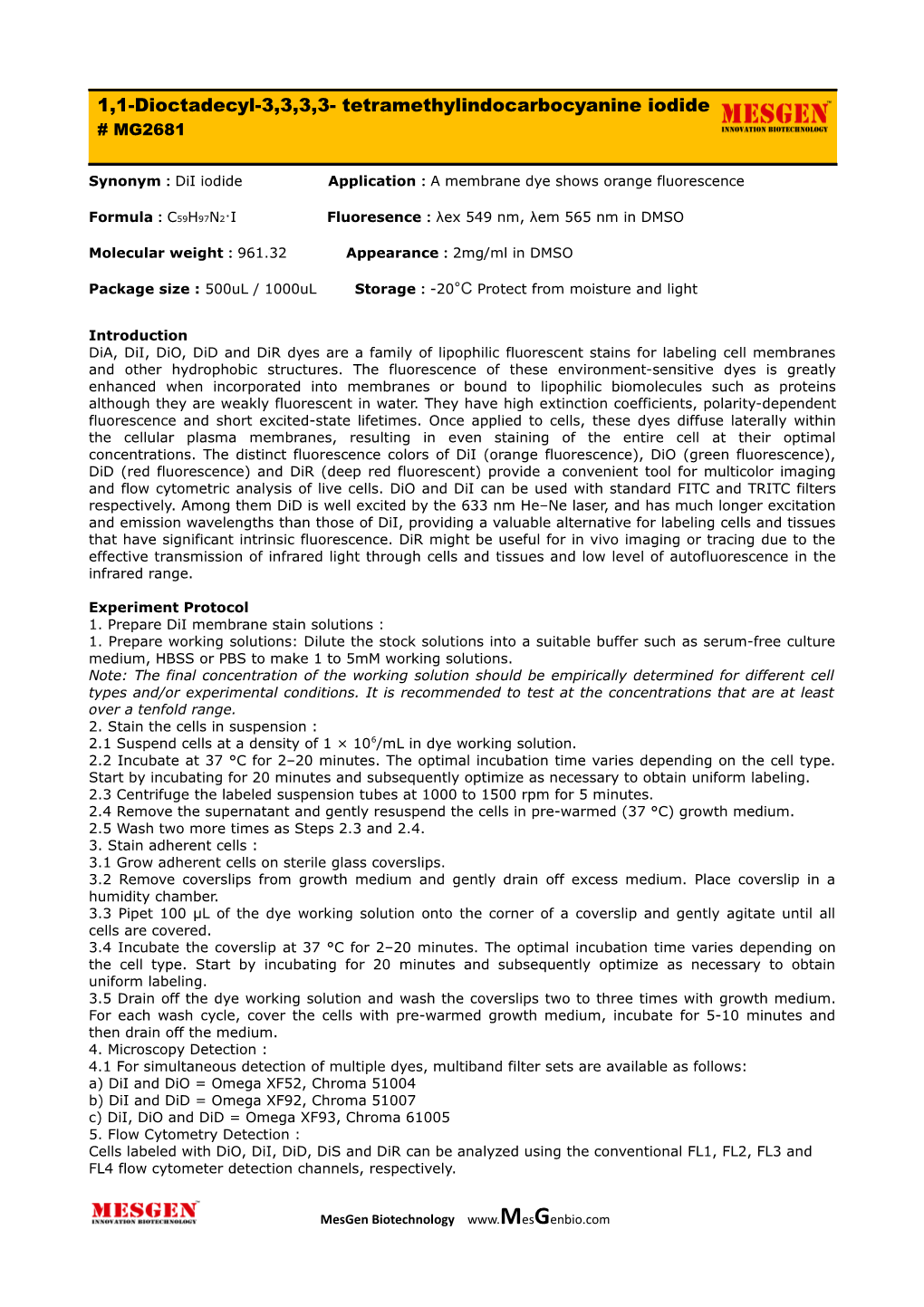# MG2681
Synonym:DiI iodide Application:A membrane dye shows orange fluorescence
Formula:C59H97N2·I Fluoresence:λex 549 nm, λem 565 nm in DMSO
Molecular weight:961.32 Appearance:2mg/ml in DMSO
Package size : 500uL / 1000uL Storage:-20°C Protect from moisture and light
Introduction
DiA, DiI, DiO, DiD and DiR dyes are a family of lipophilic fluorescent stains for labeling cell membranes and other hydrophobic structures. The fluorescence of these environment-sensitive dyes is greatly enhanced when incorporated into membranes or bound to lipophilic biomolecules such as proteins although they are weakly fluorescent in water. They have high extinction coefficients, polarity-dependent fluorescence and short excited-state lifetimes. Once applied to cells, these dyes diffuse laterally within the cellular plasma membranes, resulting in even staining of the entire cell at their optimal concentrations. The distinct fluorescence colors of DiI (orange fluorescence), DiO (green fluorescence), DiD (red fluorescence) and DiR (deep red fluorescent) provide a convenient tool for multicolor imaging and flow cytometric analysis of live cells. DiO and DiI can be used with standard FITC and TRITC filters respectively. Among them DiD is well excited by the 633 nm He–Ne laser, and has much longer excitation and emission wavelengths than those of DiI, providing a valuable alternative for labeling cells and tissues that have significant intrinsic fluorescence. DiR might be useful for in vivo imaging or tracing due to the effective transmission of infrared light through cells and tissues and low level of autofluorescence in the infrared range.
Experiment Protocol
1. Prepare DiI membrane stain solutions :
1. Prepare working solutions: Dilute the stock solutions into a suitable buffer such as serum-free culture medium, HBSS or PBS to make 1 to 5mM working solutions.
Note: The final concentration of the working solution should be empirically determined for different cell types and/or experimental conditions. It is recommended to test at the concentrations that are at least over a tenfold range.
2. Stain the cells in suspension :
2.1 Suspend cells at a density of 1 × 106/mL in dye working solution.
2.2 Incubate at 37 °C for 2–20 minutes. The optimal incubation time varies depending on the cell type. Start by incubating for 20 minutes and subsequently optimize as necessary to obtain uniform labeling.
2.3 Centrifuge the labeled suspension tubes at 1000 to 1500 rpm for 5 minutes.
2.4 Remove the supernatant and gently resuspend the cells in pre-warmed (37 °C) growth medium.
2.5 Wash two more times as Steps 2.3 and 2.4.
3. Stain adherent cells :
3.1 Grow adherent cells on sterile glass coverslips.
3.2 Remove coverslips from growth medium and gently drain off excess medium. Place coverslip in a humidity chamber.
3.3 Pipet 100 μL of the dye working solution onto the corner of a coverslip and gently agitate until all cells are covered.
3.4 Incubate the coverslip at 37 °C for 2–20 minutes. The optimal incubation time varies depending on the cell type. Start by incubating for 20 minutes and subsequently optimize as necessary to obtain uniform labeling.
3.5 Drain off the dye working solution and wash the coverslips two to three times with growth medium. For each wash cycle, cover the cells with pre-warmed growth medium, incubate for 5-10 minutes and then drain off the medium.
4. Microscopy Detection :
4.1 For simultaneous detection of multiple dyes, multiband filter sets are available as follows:
a) DiI and DiO = Omega XF52, Chroma 51004
b) DiI and DiD = Omega XF92, Chroma 51007
c) DiI, DiO and DiD = Omega XF93, Chroma 61005
5. Flow Cytometry Detection :
Cells labeled with DiO, DiI, DiD, DiS and DiR can be analyzed using the conventional FL1, FL2, FL3 and FL4 flow cytometer detection channels, respectively.
For Research Use Only. Not Intended for Diagnostic or Therapeutic Use.
MesGen Biotechnology enbio.com
